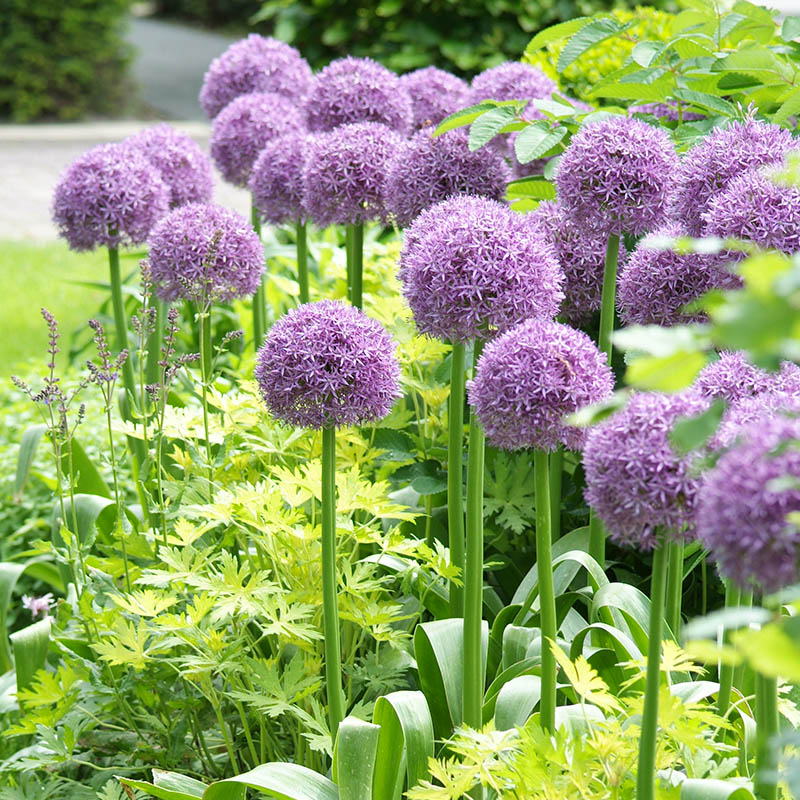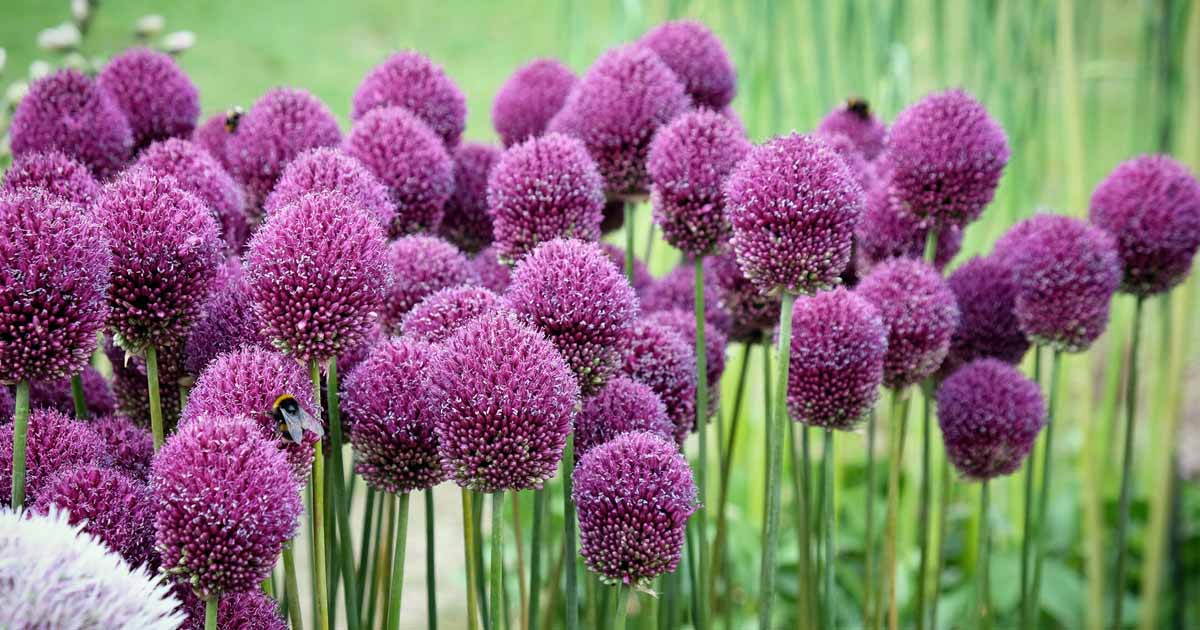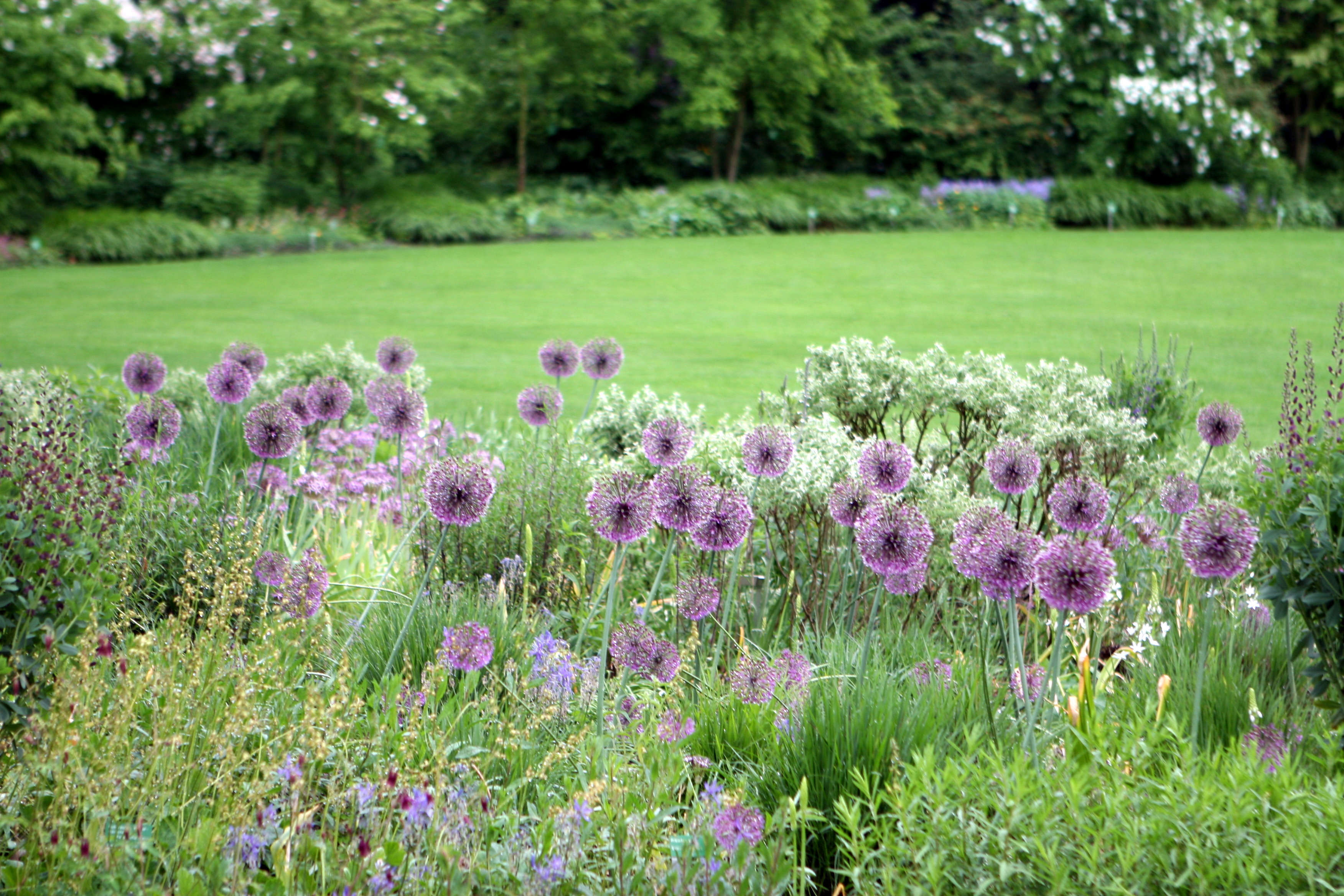Unlocking the Secrets of Allium Companion Planting
Companion planting is an ancient practice that involves pairing different plants to enhance their growth, health, and productivity. Alliums, which include garlic, onions, leeks, and chives, are ideal candidates for companion planting due to their unique characteristics. These plants are natural repellents for many pests, including aphids, mites, and nematodes, making them a valuable addition to any garden. By understanding the benefits of companion planting with alliums, gardeners can create a more diverse and resilient garden ecosystem.
One of the primary advantages of companion planting with alliums is their ability to improve soil health. Alliums have a deep taproot that helps to break up compacted soil and bring up nutrients from the subsoil. This makes them an excellent choice for planting alongside vegetables that require well-draining soil, such as carrots and beets. Additionally, alliums are natural fungicides, which can help to prevent diseases such as powdery mildew and rust.
When considering what to plant with alliums, it’s essential to think about the specific growing conditions required by each plant. Alliums prefer well-draining soil and full sun, making them an excellent choice for planting alongside other sun-loving plants. They also have a relatively low water requirement, making them an ideal choice for gardens with limited water resources.
By incorporating alliums into a companion planting strategy, gardeners can create a more diverse and resilient garden ecosystem. This approach can help to reduce the need for pesticides and fertilizers, while also improving soil health and promoting biodiversity. Whether you’re a seasoned gardener or just starting out, companion planting with alliums is a simple and effective way to create a thriving and sustainable garden.
Choosing the Perfect Companions: Flowers and Herbs that Thrive with Alliums
When it comes to choosing the perfect companions for alliums, there are many flowers and herbs that complement their unique characteristics. One of the most popular options is succulents, which share similar growing conditions with alliums. Succulents like aloe, agave, and echeveria are low-maintenance and drought-tolerant, making them an ideal choice for pairing with alliums.
Herbs like rosemary and thyme are also excellent companions for alliums. These herbs have similar growing requirements and can benefit from the natural pest-repellent properties of alliums. Rosemary, in particular, is a great choice for companion planting with alliums, as it can help to improve their growth and flavor.
Other flowers that thrive with alliums include marigolds, nasturtiums, and calendulas. These flowers are easy to grow and can add a pop of color to the garden. They also have natural pest-repellent properties that can help to protect alliums from pests.
When deciding what to plant with alliums, it’s essential to consider the specific growing conditions required by each plant. Alliums prefer well-draining soil and full sun, making them an excellent choice for planting alongside other sun-loving plants. They also have a relatively low water requirement, making them an ideal choice for gardens with limited water resources.
Some other flowers and herbs that can be planted with alliums include:
- Lavender: This fragrant herb is a natural pest repellent and can help to improve the growth and flavor of alliums.
- Chamomile: This calming herb can help to reduce stress and promote relaxation in the garden.
- Dill: This versatile herb can be used to repel pests and improve the growth of alliums.
By choosing the right companions for alliums, gardeners can create a beautiful and functional garden that is both productive and low-maintenance.
Vegetable Pairings: How to Grow Alliums with Tomatoes, Peppers, and More
When it comes to companion planting with alliums, vegetables are a natural choice. Alliums have a number of benefits that make them an ideal companion for many popular vegetables. For example, alliums can help to repel pests that target vegetables, such as aphids and spider mites. They can also improve the growth and flavor of vegetables by adding nutrients to the soil.
One of the most popular vegetable pairings for alliums is tomatoes. Tomatoes and alliums have similar growing requirements and can benefit from each other’s pest-repellent properties. To grow tomatoes with alliums, plant the alliums around the base of the tomato plants. This will help to repel pests and improve the growth of the tomatoes.
Peppers are another popular vegetable that can be paired with alliums. Like tomatoes, peppers have similar growing requirements to alliums and can benefit from their pest-repellent properties. To grow peppers with alliums, plant the alliums around the base of the pepper plants. This will help to repel pests and improve the growth of the peppers.
Other vegetables that can be paired with alliums include:
- Cucumbers: Alliums can help to repel aphids and other pests that target cucumbers.
- Carrots: Alliums can help to improve the growth and flavor of carrots by adding nutrients to the soil.
- Beans: Alliums can help to repel pests that target beans, such as aphids and spider mites.
When deciding what to plant with alliums, it’s essential to consider the specific growing requirements of each plant. Alliums prefer well-draining soil and full sun, making them an excellent choice for planting alongside other sun-loving vegetables. They also have a relatively low water requirement, making them an ideal choice for gardens with limited water resources.
Some tips to keep in mind when planting alliums with vegetables include:
- Plant alliums around the base of the vegetable plants to help repel pests.
- Make sure to leave enough space between the alliums and vegetables to allow for proper growth.
- Water and fertilize the alliums and vegetables regularly to ensure proper growth.
By following these tips and choosing the right vegetable pairings for alliums, gardeners can create a beautiful and productive garden that is both beneficial and delicious.
How to Create a Stunning Allium and Perennial Border
Creating a beautiful and functional border featuring alliums and perennials is a great way to add visual interest and diversity to your garden. Alliums, with their striking flowers and foliage, pair perfectly with perennials, which offer a wide range of textures, colors, and growth habits. By combining these two types of plants, you can create a stunning border that will attract pollinators, provide year-round interest, and require minimal maintenance.
To create a beautiful allium and perennial border, start by selecting a variety of perennials that complement the alliums. Consider plants with different growth habits, such as tall and short, and a range of textures, such as smooth and fuzzy. Some popular perennials that pair well with alliums include:
- Daylilies: These versatile perennials offer a range of colors and textures and can thrive in a variety of conditions.
- Coneflowers: With their striking flowers and drought tolerance, coneflowers are a great choice for pairing with alliums.
- Salvias: These fragrant perennials attract pollinators and offer a range of colors and textures.
When designing your border, consider the color scheme and texture of the plants. Alliums come in a range of colors, including purple, pink, and white, so choose perennials that complement these hues. You can also consider the texture of the plants, such as smooth or fuzzy, to add depth and interest to the border.
In terms of maintenance, alliums and perennials are relatively low-maintenance plants. They require minimal watering and fertilization, and can thrive in a variety of conditions. However, it’s essential to deadhead the alliums regularly to encourage new growth and prevent the plants from becoming leggy.
Some tips to keep in mind when creating an allium and perennial border include:
- Plant the alliums in the spring or fall, when the weather is cooler, to ensure optimal growth.
- Choose perennials that are suitable for your climate and soil type.
- Consider the mature size of the plants and leave enough space between them for proper growth.
By following these tips and choosing the right combination of alliums and perennials, you can create a stunning border that will add beauty and diversity to your garden.
The Benefits of Planting Alliums with Native Wildflowers
Planting alliums with native wildflowers is a great way to create a beautiful and beneficial garden ecosystem. Native wildflowers are adapted to the local climate and soil conditions, making them a perfect match for alliums. By pairing alliums with native wildflowers, you can create a low-maintenance meadow that attracts pollinators and provides a haven for wildlife.
One of the main benefits of planting alliums with native wildflowers is the attraction of pollinators. Alliums are a rich source of nectar and pollen, making them a favorite of bees, butterflies, and other pollinators. Native wildflowers also attract pollinators, and by planting them together with alliums, you can create a pollinator-friendly garden that is buzzing with life.
Another benefit of planting alliums with native wildflowers is the creation of a low-maintenance meadow. Native wildflowers are adapted to the local climate and soil conditions, making them drought-tolerant and resistant to pests and diseases. Alliums are also low-maintenance plants that require minimal watering and fertilization. By planting them together, you can create a meadow that requires minimal upkeep and maintenance.
Some popular native wildflowers that pair well with alliums include:
- Black-eyed Susans: These daisy-like flowers are a favorite of pollinators and add a bright yellow color to the garden.
- Coneflowers: These fragrant flowers attract pollinators and add a touch of elegance to the garden.
- Butterfly Milkweed: This perennial flower attracts butterflies and adds a splash of orange color to the garden.
When planting alliums with native wildflowers, be sure to choose plants that are suitable for your climate and soil type. Also, consider the mature size of the plants and leave enough space between them for proper growth.
Some tips to keep in mind when planting alliums with native wildflowers include:
- Plant the alliums in the spring or fall, when the weather is cooler, to ensure optimal growth.
- Choose native wildflowers that are adapted to your local climate and soil conditions.
- Consider the mature size of the plants and leave enough space between them for proper growth.
By following these tips and choosing the right combination of alliums and native wildflowers, you can create a beautiful and beneficial garden ecosystem that attracts pollinators and provides a haven for wildlife.
Deer-Resistant and Fragrant: Planting Alliums with Other Deterrents
When it comes to companion planting with alliums, one of the most significant benefits is the ability to deter deer and other pests. Alliums are known to be deer-resistant, and when paired with other fragrant plants, they can create a powerful deterrent that keeps deer and other pests away from your garden.
One of the most popular plants to pair with alliums for deer resistance is lavender. Lavender is a fragrant, low-maintenance plant that is known to repel deer and other pests. When planted with alliums, lavender can create a powerful deterrent that keeps deer away from your garden.
Another plant that pairs well with alliums for deer resistance is boxwood. Boxwood is a dense, evergreen shrub that is known to repel deer and other pests. When planted with alliums, boxwood can create a powerful deterrent that keeps deer away from your garden.
Other plants that can be paired with alliums for deer resistance include:
- Rosemary: This fragrant herb is known to repel deer and other pests, and can be paired with alliums to create a powerful deterrent.
- Thyme: This low-maintenance herb is known to repel deer and other pests, and can be paired with alliums to create a powerful deterrent.
- Garlic: This pungent plant is known to repel deer and other pests, and can be paired with alliums to create a powerful deterrent.
When planting alliums with other deer-resistant plants, be sure to choose plants that are suitable for your climate and soil type. Also, consider the mature size of the plants and leave enough space between them for proper growth.
Some tips to keep in mind when planting alliums with other deer-resistant plants include:
- Plant the alliums in the spring or fall, when the weather is cooler, to ensure optimal growth.
- Choose plants that are suitable for your climate and soil type.
- Consider the mature size of the plants and leave enough space between them for proper growth.
By following these tips and choosing the right combination of alliums and deer-resistant plants, you can create a powerful deterrent that keeps deer and other pests away from your garden.
Tips for Planting and Caring for Alliums in Companion Plantings
When planting alliums in companion plantings, there are several tips to keep in mind to ensure optimal growth and health. Here are some practical tips for planting, watering, and fertilizing alliums in companion plantings:
Planting:
- Choose a location with full sun to partial shade, depending on the specific allium variety.
- Plant alliums in well-draining soil with a pH between 6.0 and 7.0.
- Space alliums 3-6 inches apart, depending on the variety.
Watering:
- Water alliums regularly during the growing season, but avoid overwatering.
- Reduce watering during the dormant season to prevent rot and other diseases.
Fertilizing:
- Fertilize alliums in the spring with a balanced fertilizer.
- Avoid fertilizing during the dormant season, as this can promote weak growth.
Deadheading:
- Remove spent flowers to promote new growth and prevent seed production.
- Deadhead alliums regularly to maintain their appearance and promote healthy growth.
Division:
- Divide alliums every 3-4 years to maintain their health and promote new growth.
- Divide alliums in the spring or fall, when the weather is cooler.
By following these tips, you can ensure optimal growth and health for your alliums in companion plantings. Remember to choose the right companion plants for your alliums, and don’t hesitate to experiment with different combinations to find what works best for you.
Common Mistakes to Avoid When Companion Planting with Alliums
While companion planting with alliums can be a rewarding and beneficial experience, there are several common mistakes to avoid in order to ensure optimal growth and health for your plants. Here are some common mistakes to avoid when companion planting with alliums:
Overcrowding:
- Make sure to leave enough space between each plant to allow for proper growth and air circulation.
- Avoid planting too many alliums in a small area, as this can lead to overcrowding and reduced growth.
Inadequate Sunlight:
- Most alliums require full sun to partial shade, so make sure to choose a location that receives sufficient sunlight.
- Avoid planting alliums in areas with dense shade, as this can lead to weak and spindly growth.
Poor Soil Quality:
- Make sure to plant alliums in well-draining soil with a pH between 6.0 and 7.0.
- Avoid planting alliums in areas with poor soil quality, as this can lead to reduced growth and increased susceptibility to disease.
Insufficient Watering:
- Make sure to water alliums regularly during the growing season, but avoid overwatering.
- Avoid planting alliums in areas with poor drainage, as this can lead to root rot and other problems.
By avoiding these common mistakes, you can ensure optimal growth and health for your alliums and enjoy the many benefits of companion planting with these versatile and beautiful plants.







:max_bytes(150000):strip_icc()/Alliums-57f37bb23df78c690ff18e41.jpg)

